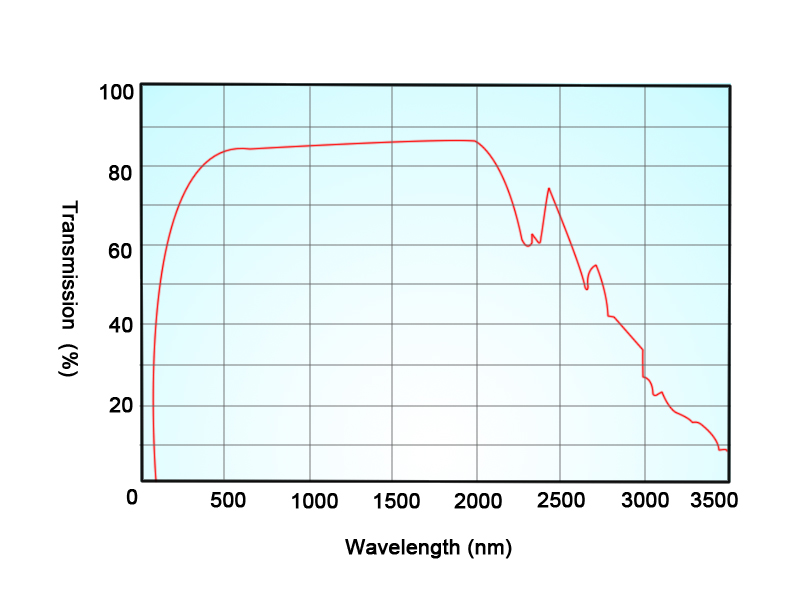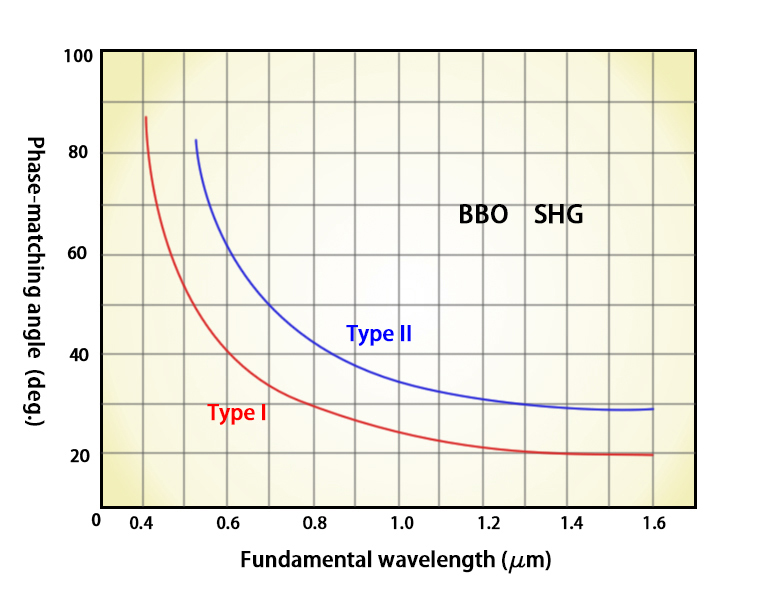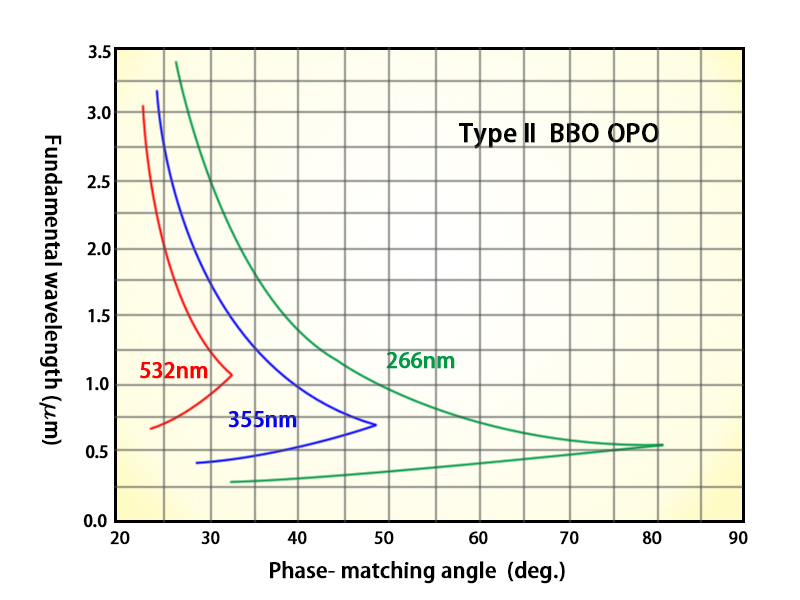Beta Barium Borate (or Beta BBO) Crystal, with the chemical formula BaB2O4, is a kind of negative uniaxial crystal with a trigonal structure. BBO crystal is one of the most prevalent nonlinear optical crystals. BBO crystal manifests outstanding optical features including its high nonlinear optical coefficient, stability over temperature changes, broad optical transmission range of 189-3500 nm, and a high damage threshold. What's more important, the advent of BBO crystals fills the shortage of nonlinear crystals that generate ultraviolet wavelengths, offering coverage for UV output which is not possible to be obtained with fundamental wavelengths. The crystal has a Second Harmonic Generation (SHG) coefficient 3-6 times larger than currently procurable ADP and KDP crystals in the near-infrared, visible, and ultraviolet spectrum. Its damage threshold is 15Gw/cm^2, which is 200% higher than that of KDP, and much higher than that of LiNbO3. In addition, its optical homogeneity (δn ≈10-6/cm) is also impressive.
These characteristics made Beta BBO crystals versatile for various NLO applications such as Harmonic Generations (e.g. SHG, THG, Fourth Harmonic Generation, Fifth Harmonic Generation), Optical Parametric Oscillations(OPO), Optical Parametric Amplifiers(OPA), and other applications in the field of Quantum Optics( quantum entanglement) and EO applications.
Hangzhou Shalom EO offers off-the-shelf and customized BBO Crystals for nonlinear optical applications. Besides the advantages of high frequency conversion efficiencies, wide transmission spectrum, broad phase matching range, our BBO crystals feature the availability of large-dimension single crystals and low thermal-optical coefficients which promote thermal stability. The crystals are grown leveraging state-of-the-art fabrication techniques, which endows the BBO crystals with high optical homogeneity. Coating options are miscellaneous, including P-coating/ multi-layer V-coating/ single, dual-wavelength AR coating. The ultra-thin 0.01mm thickness with fused silica substrates and 0.05mm thickness free-standing BBO crystals are available For Femto-line Lasers, ultra-thin crystals are available, and the minimum thicknesses are 0.01mm (mounted with Fused Silica Substrates) and 0.05mm (Free-standing). Shalom EO also provides BBO crystals for Electro-Optic (EO) modulations, with high-precision polishing and Cr-Au electrodes furnished.
Shalom EO's BBO Crystals feature:
The transmission rate and the tuning angles of second harmonic generation(SHG) of BBO crystals are shown in Fig.1 and Fig.2 separately below:


Fig.1 Transmission Curve of BBO Fig.2 Tuning Curves of Type 1 and Type 2 SHG
Applications of BBO Crystals in the field of NLOs:
1. BBO for Second, Third, Fourth, and Fifth Harmonic Generation of Nd: YAG Lasers:
Exceptional conversion efficiencies could be achieved using BBO crystals, which are greater than 70% (SHG), 60% for THG, 50% for 4thHG. BBO crystal is the best option for 213nm 5HG.
BBO crystals excel in handling intracavity SHG of Nd:YAG lasers with high power densities to generate 532nm output. And 263nm output with a decent power level could be attained using a Brewster-angle-cut BBO crystal when pumping the Nd:YAG Laser with an SHG output of a mode-locked Nd:YLF laser.
Because of a small acceptance angle and large angular walk-off, good laser beam quality (small divergence, good mode condition, etc.) is the crucial factor for BBO to function better, tight focusing of laser beams is not suggested.
2. BBO for Harmonic Generations of Other Tunable Lasers:
For SHG and THG of ultra-fast Lasers, BBO also exhibits a great advantage over KDP and ADP crystals.
BBO crystal is an effective media for SHG of XeCl-laser pumped Dye lasers for producing output in the ultra-violet spectrum (205-310nm).
SHG/THG of Alexandrite Lasers UV output in the region 360nm-390 nm and output in the region 244nm - 259 nm. SHG/THG/FHG of Ti:Sapphire Lasers could also be realized efficiently.
Intracavity SHG of Argon Doped Lasers for UV and Deep-UV output, and SHG of Copper-Vapor Lasers for UV output.
3. BBO for Optical Parametric Oscillation (OPO)/Optical Parametric Amplification (OPA):
Utilizing BBO crystals for optical parametric oscillation(OPO) and parametric optical amplification (OPA), one could easily obtain tunable output in a broad wavelength range (from the UV to IR). Common applications include:
our BBO Crystals could support OPO output of 532nm pumped laser with decent conversion efficiencies.
Using Shalom EO’s BBO, OPO of 355nm Nd:YAG pumped lasers could produce a wide tunable approximate wavelength range from UV to the MWIR spectrum, with promising conversion efficiencies.
OPA of BBO crystals generates narrow-band, high power, and tunable (400 nm to 2000 nm) pulses for a pico-second Nd-YAG pumped laser. The approach is way better than using Dye Lasers in terms of efficiencies, tunable range, and maintenance.
The Tuning Angles of Type 1 and Type 2 OPO and OPA at 532nm, 355nm, and 266nm are collected and illustrated in Fig. 3 and Fig. 4, respectively.


Fig.3 Type 1 BBO OPO Tuning Curves (@532/355/266nm) Fig.4 Type 2 BBO OPO Tuning Curves (@532/355/266nm)
4. BBO Crystals for EO applications:
BBO Crystals could be utilized for electro-optical modulations with their high laser-induced damage threshold (LIDT) and wide transmission range from 190nm to 3500nm. BBO Crystals are excellent candidates for high-repetition-rate Q-switching. We provide BBO Crystals for EO applications that are high-precision laser-grade polished and coated Cr-Au electrodes.